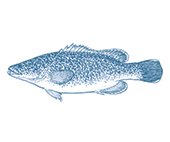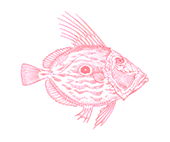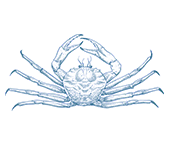




- Eat Less
Wild Caught
Region:
NSW
- Spanner crabs are caught using trap-like tangle nets, known as dillies, deployed over sand. It is a highly targeted fishing method.
- The NSW Spanner Crab Fishery operates in coastal and offshore waters in the north of the State.
- The spanner crab population is shared between NSW and QLD waters and fisheries, and is slightly below a healthy level in NSW.
- The fishing method has a fairly low impact on habitat although they potentially pose an entanglement risk for marine mammals and turtles because the fishery operates in areas that overlap with habitat for a range of threatened and endangered marine wildlife. However the fishing method employed ensures minimal risk.
- Observer programs are mandated in the fishery but conducted irregularly and incontestably. Thorough independent observer coverage would result in more accurate records of the marine wildlife caught.
- Marine parks in NSW provide the most effective science based protection from the significant ecological risks posed by fishing, but alarmingly, at the time of writing, the NSW Government was considering opening highly protected marine parks to fishing.





Spanner crabs have fine, sweet meat well suited to tossing through pasta or making seafood cocktails, salads, or sandwiches. Crabs can be purchased whole (cooked or raw) or as picked and frozen meat. To cook whole crabs, crack any large legs or claws with the back of a knife and then steam, boil or stir-fry. If cooking whole, weigh your crab and cook for 1 minute for every 100g, adding 2 minutes to the total (e.g. 550g + 2 = 7.5 minutes. Alternatively, crabs can be broken into equal sized pieces and dropped into a soup, stew or curry. Crabs are cooked when the shell goes a vivid orange or red colour and meat pulls away from the shell with ease.
- NSW Ocean Trap and Line Fishery (88t in 2019/20)
Spanner crabs are found throughout the Indo-Pacific region in coastal waters to a depth of 70m. On the east coast of Australia, they are distributed from Yeppoon in Queensland to Nowra in New South Wales. They are caught in commercial fisheries in QLD and NSW
There are some concerns over the health of spanner crab populations in NSW, based in large part on issues in the QLD fishery which takes >80% of the total catch of the shared eastern Australian population . Commercial catch rates in Queensland have declined over the last decade although depleted stocks now appear to be rebuilding from a dangerous low in 2017. A basic scientific assessment in the NSW fishery suggests populations are slightly below healthy levels, but not seriously overfished,
The fishery in which spanner crabs are caught is subject to federal government accreditation which allows it to export the species it catches overseas. But the NSW Department of Primary Industries (DPI) was, at the time of writing, non compliant with these conditions because it had not implemented accurate bycatch reporting of threatened shark species.
Northern areas of the line component of the fishery were subject to an observer study in 2019, and another study on this section was published in 2015, but based on data from 2007-09. A more recent study has not been made publicly available which is a concern. Observer management is absent for the trap component of the fishery. This partial approach also falls short of best practice.
Spanner crabs are likely to be important prey for some shark and ray species.
Marine parks in NSW provide the most effective science based protection for the ecological risks posed by fishing, but alarmingly, at the time of writing, the NSW Government was considering opening highly protected marine parks to fishing.


